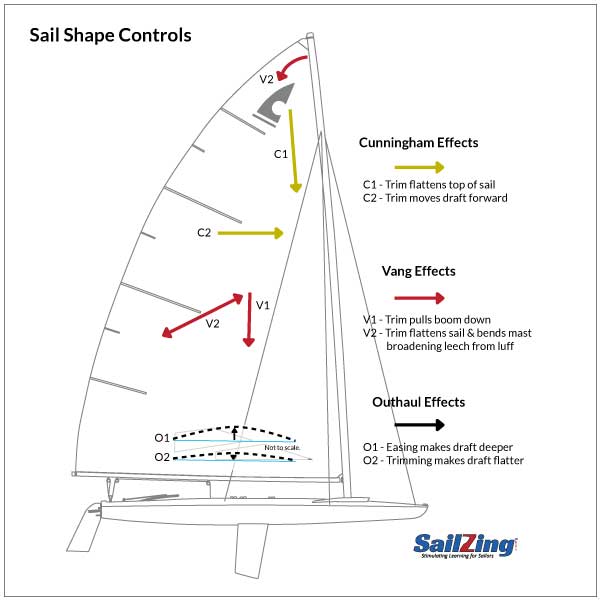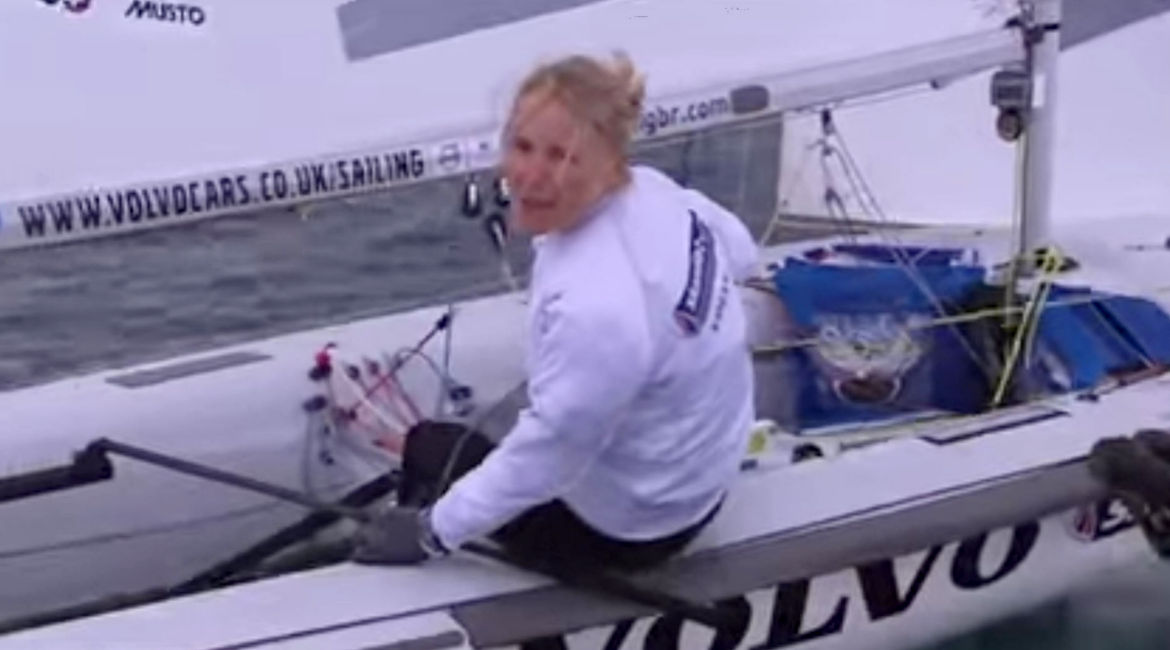Our recent post, Learn to Change Gears, focused on three upwind “gears:” footing, pointing, and max VMG. These gears rely on changing the angle of attack. In this post we address another form of gears: using sail controls, rig tuning and boat trim as powering up and depowering tools.
This post assumes you understand basic sail shape concepts and the function of the sail controls. Refer to our series on Shaping Your Mainsail for background.
Seven Depowering Tools
Most boats have the sail controls and rigging to power up and depower the rig in various wind and wave conditions. For this discussion, we’ll use the common controls on a cat-rigged boat. We’ll focus on depowering; powering up uses the same controls and sequences in reverse.
#1. Outhaul
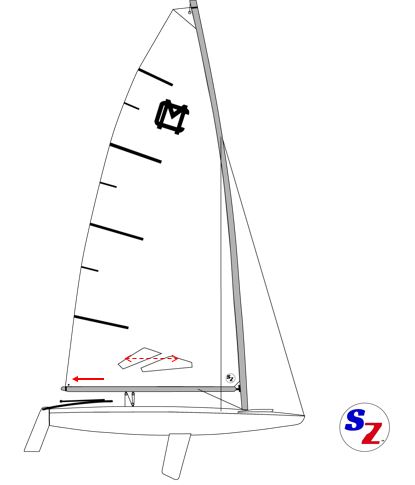
Several top sailors use outhaul as their first depowering tool since it has the least impact on other aspects of sail shape.
Tension the outhaul to flatten the sail near the foot, reducing power and drag.
- Reducing power near the foot is not as costly as it might seem, since some power near the foot is wasted due to “leakage” flow under the boom.
- Don’t over-flatten the foot. This opens the lower leech and reduces pointing ability, especially when you are depowering the rest of the sail. Consider using a leech ribbon on the end of the bottom batten. If it’s always streaming the lower leech may be too open.
#2. Vang
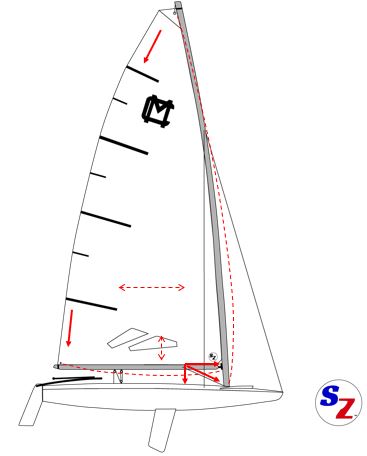
To depower successfully you must use the boom vang. Vang tension flattens the bottom two-thirds of the sail. The tension needed depends on mast bend and sail design. Use more vang when the mast doesn’t bend as easily or when the sail has a lot of luff curve.
- Vang tension has a point of diminishing returns
- With too much vang tension, the sail entry can get too flat and becomes a hard spot in the sail, never reacting to changes. The leeward luff telltales won’t stream, indicating loss of lift.
- Too much vang tension may also tighten the upper leech, leaving it unresponsive to puffs.
- Vang sheeting is a common way of responding to puffs and lulls. Use a relatively tight vang and work the mainsheet aggressively, easing in puffs to let the top of the sail twist open. Trim in as soon as the brunt of the puff subsides. See our post, Vang Sheeting and Snugging for more.
#3. Traveler
In cat-rigged boats, many sailors position the traveler car below centerline (i.e., “drop” the traveler) as soon as they are hiking hard and especially in waves.
- Drop the traveler to increase the forward component of lift and reduce the side force. This has minimal effect on pointing since the increased boat speed will give the boards more bite.
- With the traveler dropped, sheet the main very hard to keep the sail flat. The reduced side force allows you to sheet harder and still maintain control. You won’t need to work the mainsheet as much as when you are vang sheeting with the traveler centered.
#4. Cunningham
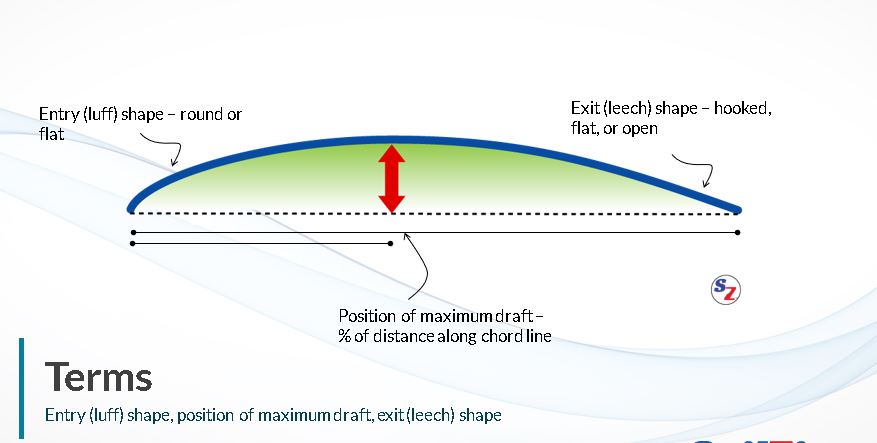
Tension the cunningham progressively to compensate as the wind builds. More wind forces the maximum draft aft (50% aft or more). Cunningham tension returns the draft position to 40-50% aft.
- Draft > 50% aft is undesirable since it increases side force and hooks the upper leech, creating additional weather helm.
- The cunningham is more effective in sails with a longer chord length at the top of the sail (e.g., C scows)
- Cunningham tension may also contribute to mast bend if pulled very hard with a bendy mast.
#5. Luff the Mainsail
This is an easy way to depower and is often necessary in big puffs. However, luffing the sail markedly increases drag. Avoid luffing the sail routinely except in extreme conditions when you’ve already maxed out the other options.
#6. Board Height
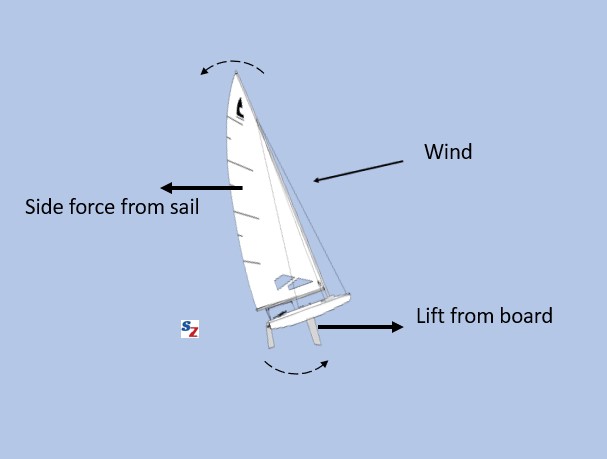
Raise the centerboard/daggerboard/bilge board to depower the boat’s response. See our post, Raise Your Board in Heavy Air – Three Reasons for the effect on angle of heel, drag, and weather helm.
#7. Rig Tuning and Mast Bend
Sailmakers’ tuning guides address mast bend. The guides for sophisticated rig designs address both lateral and fore-and-aft bend, with different settings for different wind conditions. We’ll give the basics here and cover more in a future post on rig tuning.
- Lateral mast bend
- If the mid-mast sags to leeward, the upper mast will poke to windward. This condition generates more power, since the mid sail will become fuller, and the upper leech will stay closed longer.
- If the mid-mast pokes to windward, the upper mast will fall off to leeward. This reduces power.
- Fore-and-aft mast bend
- More fore-and-aft bend reduces power since it flattens the sail.
- Other considerations
- Rig tuning also keeps the mast shape from changing too much as the wind builds. That’s why many tuning guides recommend tightening the rig in heavier air. In extreme cases, this prevents mast failure from too much bend.
- Ideally, a rig will respond automatically to changes in wind. For example, in some designs, the mid-mast will sag to leeward when underpowered and poke to windward when overpowered.
Experiment with Combinations
Find the right combination of these controls for your boat in different conditions, using two-boat testing. Here are some things to try:
- Use the outhaul as your first depowering tool.
- If you don’t routinely use the vang much, try using it earlier. Once the boat is up to speed, flattening the sails aids pointing. Just be sure to power back up if you’re not hiking or if the boat slows.
- Add cunningham tension as you add vang, since the vang and increased wind tends to move the draft aft.
- Experiment with traveler position. Some sailors vang sheet and drop traveler as a last resort. Others drop traveler early and rely less on vang sheeting. Still others cleat the main and play the traveler in puffs.
- To control weather helm, combine dropping the traveler and raising the boards. Do this in small increments: too much of either will reduce pointing.
Transitions
The fastest sailors transition continually between powering up and depowering. See our post, Do You Have the Right Touch? to get inspired about the need for transitions. Unfortunately, sailboats don’t have accelerator pedals and automatic transmissions, making transitions a skill that needs constant practice.
Related Content
Sail Power: Depowering & Powering-Up – North Sails

